1st Queen's at Quetta - The Earthquake
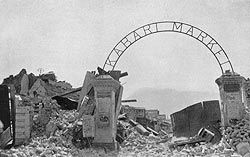 |
| The Market Place (Click to enlarge) |
1st Queen’s left China for India in November 1934. They received, fittingly, after a highly successful tour, a splendid send-off. As they marched to the station at Tientsin they encountered an illuminated message on one building saying “Bon Voyage to the Queen’s” and at the station large crowds of friends made entrainment extremely difficult. The voyage was uneventful. At Hong Kong seventy-six members of the Battalion departed for England and a further 120 left at Karachi, but the numbers were made up by a reinforcement draft shortly after reaching Quetta. The battalion arrived at their new station a week before Christmas after thirty-six hours in the train, the latter part through snow-clad mountains.
Quetta is nearly six thousand feet above sea level and bitterly cold in winter. The train journey from Karachi involved crossing the Sind Desert and climbing the famous Bolan Pass which had tested the old Queen’s Royals so hard almost a hundred years previously at the beginning of the First Afghan War. The Battalion was now part of a large garrison comprising every branch of the British and Indian Armies and a large RAF detachment. Mess staffs set about making the somewhat barren messes and canteen more homely. There were numerous football and hockey grounds and the battalion football eleven soon made a name for itself by winning the Baluchistan District Championship. The polo club set about acquiring new ponies. With spring came the fruit blossom for which the area was well known, and things looked much more cheerful.
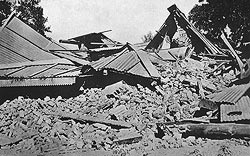 |
| A Bungalow. (Click to enlarge) |
On 31st May 1935 at 3.40 am in the early morning the city of Quetta and the countryside for 100 miles to the south-west including the town of Khelat were devastated by a severe earthquake which lasted three minutes. There was another severe shock on 2nd June.
An official Government communique issued on that day from Simla stated:
“1. The whole city of Quetta is destroyed and being sealed under military guard from 2nd June with medical advice. It is estimated that 20,000 corpses remain buried under the debris. There is no hope of rescuing any more persons alive. The corpses extracted and buried number several thousand. There are about 10,000 Indian survivors including 4,000 injured.
2. All houses in the civil area are razed to the ground except Government House, which is partially standing but in ruins. The church and club are both in ruins, also the Murree Brewery.
3. One quarter of the cantonment area is destroyed, the remaining three quarters slightly damaged, but inhabitable. Most of the damage was done in the RAF area where the barracks were destroyed, and only six out of the twenty-seven machines are serviceable.
4. The railway area is destroyed.
5. Hanna Road and the Staff College are undamaged.
6. Surrounding villages are destroyed with, it is feared, very heavy casualties. The number is not yet ascertainable. Military parties are being sent out to investigate and render help.
7. Outlying districts, as already reported from Khelat and Mastung, are reported to have been razed to the ground with heavy casualties. All the villages between Quetta and Khelat are also reported to have been destroyed”.
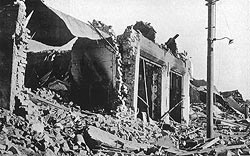 |
| A Shop (Click to enlarge) |
A local newspaper headline announced “Terrible Disaster in Quetta - Staff College unharmed”.
At the time when the earthquake occurred 1st Queen’s were returning from night operations and were marching along a main road. Had it not been for the darkness the Battalion must have presented an extraordinary sight for it was almost impossible to stand up and most of the troops either sat or fell down. One officer described how as he was lying prostrate a large chasm opened in the earth within reach of his hand, and then slowly closed again. Within a minute, however, the battalion had recovered and resumed the march. No one realised the seriousness of the situation until after they had reached barracks at about 6.30 am and dismissed for breakfast and bed, having marched eighteen miles during the night. The barracks were more or less intact although the ammunition depot at which the Battalion found a guard was in ruins, luckily without serious injury to the guard. At 7.30 a staff officer arrived from the Western Command Headquarters to describe the situation and obtain help. When the magnitude of the disaster was realised every available man was despatched to the city.
There follows a description of the first three days taken from the Regimental Journal of November 1935:
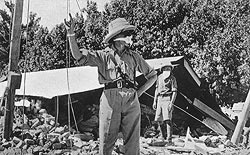 |
| Looking for Bodies. (Click to enlarge) |
“It is not possible to describe the state of the city when the battalion first saw it. It was completely razed to the ground. Corpses were lying everywhere in the hot sun and every available vehicle in Quetta was being used for the transportation of injured.
The area allotted to the battalion was the Civil Lines, which included the Residency, the post office, the civil hospital and the western end of the city. Companies were given areas in which to clear the dead and injured. Battalion Headquarters were established at the Residency. Hardly had we commenced our work than we were called upon to supply a party of fifty men, which were later increased to a hundred, to dig graves in the cemetery.
The system was to search methodically from house to house looking for the injured and the dead. The injured were removed to the hospitals and the dead were laid out on the side of the road and collected in A.T. carts.
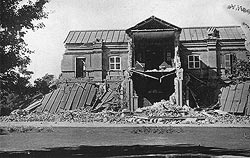 |
| The Residency. (Click to enlarge) |
Europeans and Anglo-Indians, some unidentified, were taken to the British cemetery, put into trenches dug by our men, and covered over quickly whilst the Padre read the Burial Service. Indians were removed in the same way and taken to a burial ground outside Quetta. Rescue work went on steadily throughout the day. At 8 pm we stopped. It was impossible to dig in the dark and there were no lights; furthermore, the men were exhausted, added to which they had had practically nothing to eat.
The next day, The Glorious First of June - the Battalion marched at daybreak to the city. That was to be our area for the day. It seemed a hopeless task - nothing but a pile of bricks. Dead were lying everywhere. Squatting all over the place were survivors, each in turn begging us to search this and that house for their relatives and belongings. But we had all learnt a lesson from the previous day. No longer were we going to dig for dead under the houses, but only for the living. The previous day much precious time had been wasted by digging for dead and carting them away. This time we were going to look for the living and leave the dead. This was easier said than done, for in looking for the living we came across the dead; they had to be buried at once, for already the city was beginning to smell terribly.
In our search we could be guided only by faint cries or by relatives who said that they had heard cries during the night. Frequently we brought men, women and children out alive; others were dead when we reached them; some were unfortunately killed by the digging causing a further fall of masonry. Some of those who had been buried crawled out quite unhurt; others were so crippled as to be unable to move.
Owing to the narrow streets being full of bricks and rubble it was impossible to get ambulances up, and the men had long journeys carrying the injured over piles of bricks to the nearest point where ambulances could collect.
Long before the evening the men were dead beat. It was a very hot day, the digging and burying had been terrific and the smell was hourly becoming worse. The pitiful requests of the survivors - who would do nothing to help themselves - and the sight of the dead bodies added to the strain. There was still a party at the cemetery burying Christians - Mohammedans were taken out to their burial place by cart and the Hindus burned their dead at any convenient place.
On the third day the Battalion continued working in the city. In the morning we were still digging out live people but they were fewer than before. The men had to work with medicated pads over their mouths and noses owing to the danger of disease from dead bodies. The chief job, however, was moving the survivors from the city. A big refugee camp had been opened up for them on the racecourse, tentage was supplied and water and food provided. Families were put into lorries by the men -whether they liked it or not - and taken to the racecourse.
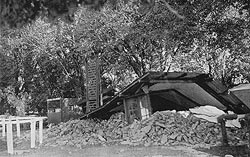 |
| Racecourse Buildings. (Click to enlarge) |
By the evening it was apparent that even if anyone was still alive they would never be found. Practically every survivor had been evacuated to the refugee camp and the city was empty except for military patrols. In the morning one party from the West Yorkshire Regiment heard faint cries and dug furiously for hours. At last they came to an opening and looked in - to find a cat and five kittens.
Not the least of our troubles was the question of what to do with the animals. The city was full of cows and water-buffaloes, and most of them had calves. The injured were shot on the spot, which only added to the smell.
On 3rd June - that is to say the fourth day - the city was sealed. By that it is meant that no one was allowed in the city, except on duty. A cordon of soldiers surrounded the area, and for the next two days patrols were sent through the city clearing out anyone seen and shooting stray animals. Since then the city has been closed by barbed wire entanglements, patrolled day and night by soldiers at first, and now by the North West Frontier Police.
During the first day or two, when everything was disorganised, the riff-raff in the neighbourhood, and from as far as forty miles away, came to Quetta. They knew that beneath all those bricks thousands and thousands of rupees and valuables were buried; for although a few shopkeepers put their money in the bank the large majority kept it in a box under the bed.
Martial law was declared, which meant looters could be shot on sight, and the 16th Cavalry were posted on the outskirts of Quetta to stop them coming in, but it was quite impossible to prevent them all and very often tribesmen were caught looting. They were tied to railings in the most uncomfortable position possible. There they were left in the hot sun all day, and in the evening given twelve across the behind and released. It was quite an unpleasant punishment.”
There was still much to do. By 12th June all British women and children were evacuated besides thousands of refugees and over ten thousand injured, some by air but nearly all over the single railway line. Rations had to be provided for everyone, British and Indian, and thousands of horses and mules had to be foraged. Tents arrived from all over India and had to be put up, barbed wire fences had to be erected around valuable stores and ammunition, refugees had to be controlled and prevented from getting out of hand. Later, Wana huts had to be built and the remaining barracks made more earthquake proof.
The Battalion subsequently received a certificate from the Viceroy of India recording the thanks of the Government of India for their share in the work of rescue and succour “which saved so many lives and mitigated so much suffering”, and two soldiers of the battalion, Lance Corporal G. Henshaw and Private A. Brook were awarded the Empire Gallantry Medal which was later converted to the George Cross by command of King George VI.
Work on reconstruction continued almost continuously into the autumn. Conditions gradually settled down and a pleasant break was provided during the winter for all ranks by a month’s holiday in Karachi where the comparative civilisation, the warm weather and the bathing, sailing and fishing were much enjoyed.
In 1936 the battalion reverted to normal training, and in October they moved to Allahabad. The Regimental History records that “They were especially sorry to leave the Indian battalions of the brigade, the 2/11th Sikhs, 4/19th Hyderabad Regiment and the 2/8th Gurkha Rifles, who had filled them with great respect for the Indian Army.”
Related
